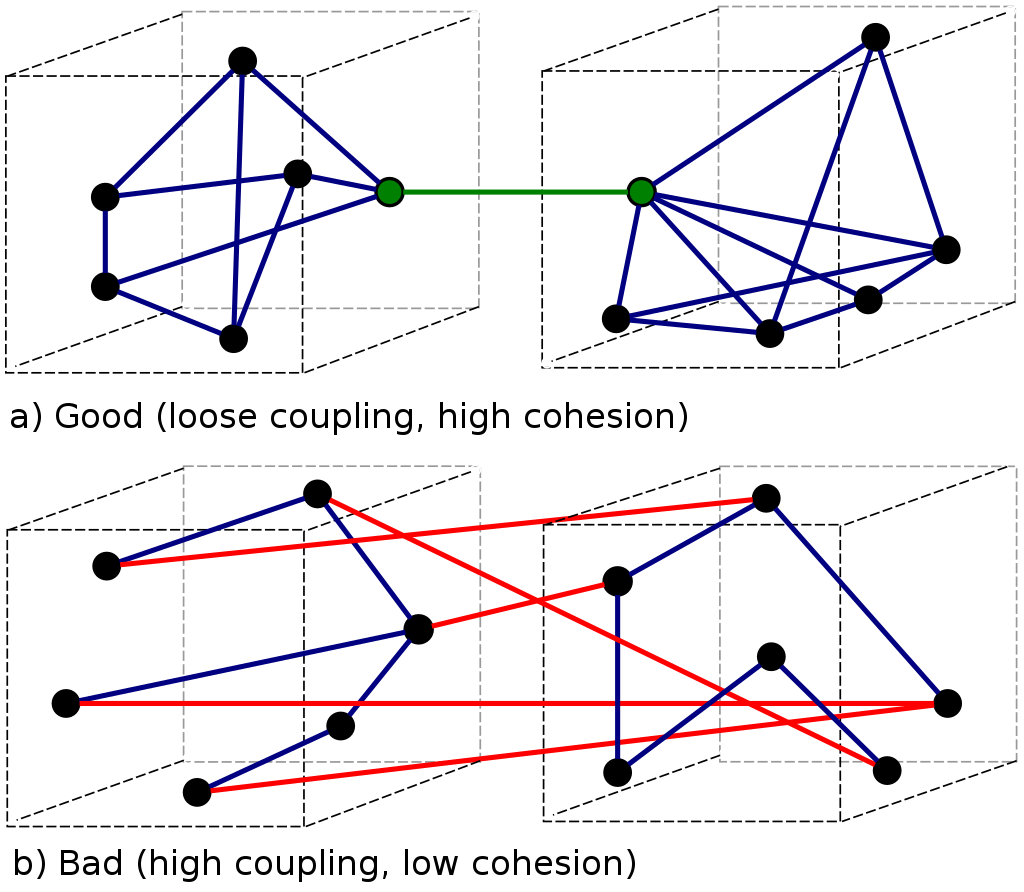What is coupling?
In object-oriented paradigm, Coupling refers to the degree of direct knowledge that one element has of another. We may generally divide coupling to tight and loose one.
We may refer for an example of those to monolith architecture, we may generally say that classic monolith is rather tight coupled, when the modular is loosely coupled (if the module are separated correctly).
But let’s think about less abstract example. A phone and a remote. What would you do if your battery in a new iPhone dies? You would probably get the new one because replacing it is difficult and costs a lot.
In the other hand what would you do if you noticed that your remote is not working, you will get new batteries and replace it in a seconds.

Why coupling is bad, most of the time?
- Its make refactor or any change of ‘HOW’ we implement something more difficult
- We are coupled to concrete implementation of ‘WHAT’ our system is doing.
- Change in one place can be a cause of a bug in the other place, which should be completely independent
- Make testing and debugging harder
- Introducing new feature will last much longer
- Code got duplicated as it’s part are hard to reuse.
Different look on coupling
But mentioned earlier thought and loose coupling, what does it mean in context of our code?
I got much better understanding of it, and how to think about it, after watching a conference talk made by Łukasz Szydło
which can be found here.
Let’s briefly go through that concept.
So we may separate a coupling in our code on four levels, starting from tightly coupled to loosely coupled one. We may
define on which level our code is by answering for following questions (levels) in context of our piece of code that we
decide to work on.
How it’s done?
Where it took place?
Who is doing it?
What happened?
We would strive to situation where our part of system can not answer for at least 3 of those (How? Where? Who?).
| Local method | Local instance | External instance | Configurable instance (DI) | Notification | |
|---|---|---|---|---|---|
| How? | V | X | X | X | X |
| Where? | V | V | X | X | X |
| Who? | V | V | V | X | X |
| What? | V | V | V | V | X |
Local method
public class SaleService {
void sendNotification(Notification notification){
//...
}
}
It’s the highest coupling, local method. SaleService does know everything about the other thing.
HOW - implementation of the method~~
WHERE - in my instance
WHO - ‘me’ - EmailSender
WHAT - email will be sent
Local instance
public class SaleService {
private ConcreteSenderImpl concreteSender = new ConcreteSenderImpl();
void sendNotification(PurchaseDetails purchaseDetails){
concreteSender.send(notification);
}
}
HOW - implementation of the method
WHERE - in my instance
WHO - ‘me’ - EmailSender
WHAT - email will be sent
We are not aware how it will be done, as it’s done by different class.
External instance
public class SaleService {
private final ConcreteSenderImpl concreteSender;
public SaleService(ConcreteSenderImpl concreteSender){
this.concreteSender = concreteSender;
}
void sendNotification(PurchaseDetails purchaseDetails){
concreteSender.send(notification);
}
}
HOW - implementation of the method
WHERE - in my instance
WHO - ‘me’ - EmailSender
WHAT - email will be sent
We decreased coupling and ‘where’ is also gone, as we don’t contain an object itself but reference to it, so It’s somewhere, but we don’t know ‘where’.
Configurable instance (Dependency Injection)
public class SaleService {
private final EmailApiService emailSender;
public SaleService(EmailApiService emailSender){
this.emailSender = emailSender;
}
void sendNotification(PurchaseDetails purchaseDetails){
emailSender.send(notification);
}
}
HOW - implementation of the method
WHERE - in my instance
WHO - ‘me’ - EmailSender
WHAT - email will be sent
It’s also dependency injection as in previous example but this one is configurable as we are injecting interface, not concrete implementation of it, and because of that we get rid of the knowledge ‘who’ will send it. It may be that library or another, or we may send an event to external service and so on. We know that email will be sent, but we don’t know by ‘who’. This type of coupling is the most common one, and in most of the cases it’s ok, it’s enough. But we can make it ever weaker…
Notification
public class SaleService {
private final EventDelegator eventDelegator;
public SaleService(EventDelegator eventDelegator){
this.emailSender = emailSender;
}
void sendNotification(PurchaseDetails purchaseDetails){
eventDelegator.sendEvent(new ClientBoughtItem(purchaseDetails));
}
}
HOW - implementation of the method
WHERE - in my instance
WHO - ‘me’ - EmailSender
WHAT - email will be sent
With notification, we are not ‘saying’ what to do, we’re saying what happened… We are now, not aware what will be reaction to the information that we just shared. Perhaps client will receive en sms, or email, or push notification or all of them? We are just ‘saying’ what happened, and we don’t care how it will be handled.

Comments